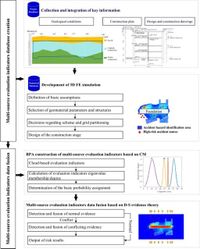A New Risk Assessment Method Enhances Safety in Foundation Excavation Projects
Researchers develop an innovative approach integrating cloud models and Dempster–Shafer evidence theory to improve safety evaluations for complex excavation processes.
Risk assessment plays a crucial role in ensuring the safety of foundation excavation projects, particularly as urban construction becomes increasingly complex and data from diverse sources is needed for accurate evaluations. In response to these challenges, a new study proposes a method that integrates cloud models (CM) with Dempster–Shafer (D–S) evidence theory to enhance the accuracy of risk assessments in foundation excavations.
The study highlights the difficulties faced during pre-excavation feasibility analysis, where limited data often hinders the identification of multidimensional risks associated with excavation safety. In light of advancing underground engineering techniques, there is a growing trend towards larger excavation scales and more densely organized structures. The researchers emphasize that these developments require comprehensive safety evaluations, leveraging multi-source data to inform decision-making processes.
To address the inadequacies of traditional risk assessment methods that rely heavily on qualitative data and simplistic averaging techniques, the team carefully created a database from various project indicators derived from geological surveys, construction plans, design drawings, and results from advanced three-dimensional finite element (FE) numerical simulations.
This innovative risk assessment method effectively fuses indicators collected through these diverse sources, applying the principles of CM to quantitatively analyze the risks involved. In practical terms, CM allows the transformation of membership degrees derived from different risk levels into basic probability assignments, which the D–S evidence theory then utilizes to produce a more nuanced and comprehensive evaluation of excavation risks.
In a case study focusing on a narrow-long foundation project, the proposed approach identified a safety risk level categorized as IV (normal), indicating that the structural design was sound and feasible. The method not only demonstrated reliability in risk assessments but also supported the formulation of preventive strategies and managerial decisions essential for foundation excavation safety.
As urban engineering continues to evolve, this assessment model marks a significant advancement in safety evaluation techniques for foundation projects. It mitigates risks by offering a balanced approach to incorporating both quantitative and qualitative data, ensuring a more thorough understanding of potential excavation challenges.
"The proposed method is capable of providing a more accurate assessment of the feasibility and design rationality of foundation excavation projects at the pre-excavation stage," wrote the authors of the article.
By combining multiple sources of evidence, this method harnesses the strengths of both statistical and heuristic modeling to create a robust framework for risk assessments. This comprehensive approach yields clearer insights into the uncertainties associated with foundation excavations and enhances decision-making capabilities, allowing engineers to optimize construction practices and reduce accident occurrences.
Furthermore, the study acknowledges the rapid pace of technological advancement within the field and emphasizes the importance of integrating emerging solutions, such as the Internet of Things (IoT), to refine risk evaluations further and establish real-time monitoring systems during the excavation process.
The research ultimately serves as a pivotal contribution to the realm of foundation engineering, providing a pathway towards a safer, more efficient construction environment.
In summation, this innovative risk assessment method, integrating CM and D–S evidence theory, is set to revolutionize the safety protocols governing foundation excavation, delivering enhanced reliability, precision, and adaptability in evaluating excavation risks.

